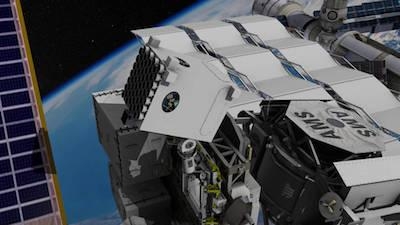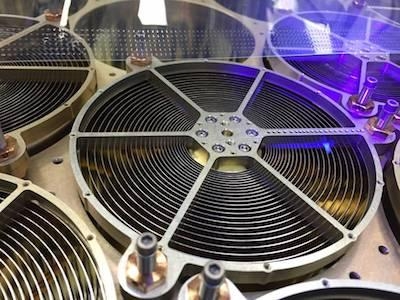SEXTANT Shows How Pulsars Can Be Used To Determine Location Of High-Speed Objects
In a technology first, a team of NASA engineers has demonstrated fully autonomous X-ray navigation in space — a capability that could revolutionize NASA’s ability in the future to pilot robotic spacecraft to the far reaches of the solar system and beyond.

The demonstration, which the team carried out with an experiment called Station Explorer for X-ray Timing and Navigation Technology, or SEXTANT, showed that millisecond pulsars could be used to accurately determine the location of an object moving at thousands of miles per hour in space — similar to how the Global Positioning System, widely known as GPS, provides positioning, navigation, and timing services to users on Earth with its constellation of 24 operating satellites.
“This demonstration is a breakthrough for future deep space exploration,” said SEXTANT Project Manager Jason Mitchell, an aerospace technologist at NASA’s Goddard Space Flight Center in Greenbelt, Maryland. “As the first to demonstrate X-ray navigation fully autonomously and in real-time in space, we are now leading the way.”
This technology provides a new option for deep space navigation that could work in concert with existing spacecraft-based radio and optical systems.
Although it could take a few years to mature an X-ray navigation system practical for use on deep-space spacecraft, the fact that NASA engineers proved it could be done bodes well for future interplanetary space travel. Such a system provides a new option for spacecraft to autonomously determine their locations outside the currently used Earth-based global navigation networks because pulsars are accessible in virtually every conceivable fight regime, from low-Earth to deepest space.
The SEXTANT technology demonstration, which NASA’s Space Technology Mission Directorate had funded under its Game Changing Program, took advantage of the 52 X-ray telescopes and silicon-drift detectors that make up NASA’s Neutron-star Interior Composition Explorer, or NICER. Since its successful deployment as an external attached payload on the International Space Station in June, it has trained its optics on some of the most unusual objects in the universe.
“We’re doing very cool science and using the space station as a platform to execute that science, which in turn enables X-ray navigation,” said Goddard’s Keith Gendreau, the principal investigator for NICER, who presented the findings Thursday, Jan. 11, at the American Astronomical Society meeting in Washington. “The technology will help humanity navigate and explore the galaxy.”
NICER, an observatory about the size of a washing machine, currently is studying neutron stars and their rapidly pulsating cohort, called pulsars. Although these stellar oddities emit radiation across the electromagnetic spectrum, observing in the X-ray band offers the greatest insights into these unusual, incredibly dense celestial objects, which, if compressed any further, would collapse completely into black holes. Just one teaspoonful of neutron star matter would weigh a billion tons on Earth.
Although NICER is studying all types of neutron stars, the SEXTANT experiment is focused on observations of pulsars. Radiation emanating from their powerful magnetic fields is swept around much like a lighthouse. The narrow beams are seen as flashes of light when they sweep across our line of sight. With these predictable pulsations, pulsars can provide high-precision timing information similar to the atomic-clock signals supplied through the GPS system.

In the SEXTANT demonstration that occurred over the Veteran’s Day holiday in 2017, the SEXTANT team selected four millisecond pulsar targets — J0218+4232, B1821-24, J0030+0451, and J0437-4715 — and directed NICER to orient itself so it could detect X-rays within their sweeping beams of light. The millisecond pulsars used by SEXTANT are so stable that their pulse arrival times can be predicted to accuracies of microseconds for years into the future.
During the two-day experiment, the payload generated 78 measurements to get timing data, which the SEXTANT experiment fed into its specially developed onboard algorithms to autonomously stitch together a navigational solution that revealed the location of NICER in its orbit around Earth as a space station payload. The team compared that solution against location data gathered by NICER’s onboard GPS receiver.
“For the onboard measurements to be meaningful, we needed to develop a model that predicted the arrival times using ground-based observations provided by our collaborators at radio telescopes around the world,” said Paul Ray, a SEXTANT co-investigator with the U. S. Naval Research Laboratory. “The difference between the measurement and the model prediction is what gives us our navigation information.”
The goal was to demonstrate that the system could locate NICER within a 10-mile radius as the space station sped around Earth at slightly more than 17,500 mph. Within eight hours of starting the experiment on November 9, the system converged on a location within the targeted range of 10 miles and remained well below that threshold for the rest of the experiment, Mitchell said. In fact, “a good portion” of the data showed positions that were accurate to within three miles.
“This was much faster than the two weeks we allotted for the experiment,” said SEXTANT System Architect Luke Winternitz, who works at Goddard. “We had indications that our system would work, but the weekend experiment finally demonstrated the system’s ability to work autonomously.”
Although the ubiquitously used GPS system is accurate to within a few feet for Earth-bound users, this level of accuracy is not necessary when navigating to the far reaches of the solar system where distances between objects measure in the millions of miles. “In deep space, we hope to reach accuracies in the hundreds of feet,” Mitchell said.
Now that the team has demonstrated the system, Winternitz said the team will focus on updating and fine-tuning both flight and ground software in preparation for a second experiment later in 2018. The ultimate goal, which may take years to realize, would be to develop detectors and other hardware to make pulsar-based navigation readily available on future spacecraft. To advance the technology for operational use, teams will focus on reducing the size, weight, and power requirements and improving the sensitivity of the instruments. The SEXTANT team now also is discussing the possible application of X-ray navigation to support human spaceflight, Mitchell added.
If an interplanetary mission to the moons of Jupiter or Saturn were equipped with such a navigational device, for example, it would be able to calculate its location autonomously, for long periods of time without communicating with Earth.
Mitchell said that GPS is not an option for these far-flung missions because its signal weakens quickly as one travels beyond the GPS satellite network around Earth.
“This successful demonstration firmly establishes the viability of X-ray pulsar navigation as a new autonomous navigation capability. We have shown that a mature version of this technology could enhance deep-space exploration anywhere within the solar system and beyond,” Mitchell said. “It is an awesome technology first.”
NICER is an Astrophysics Mission of Opportunity within NASA's Explorers program, which provides frequent flight opportunities for world-class scientific investigations from space utilizing innovative, streamlined and efficient management approaches within the heliophysics and astrophysics science areas. NASA's Space Technology Mission Directorate funds the SEXTANT component of the mission through its Game Changing Development Program.
(Images provided with NASA news release)
 Senator Pushes FAA to Accelerate Rocket Launch Licensing
Senator Pushes FAA to Accelerate Rocket Launch Licensing Classic Aero-TV: RJ Gritter - Part of Aviations Bright New Future
Classic Aero-TV: RJ Gritter - Part of Aviations Bright New Future Aero-FAQ: Dave Juwel's Aviation Marketing Stories -- ITBOA BNITBOB
Aero-FAQ: Dave Juwel's Aviation Marketing Stories -- ITBOA BNITBOB ANN's Daily Aero-Linx (10.27.24)
ANN's Daily Aero-Linx (10.27.24) ANN's Daily Aero-Term (10.27.24): Clearance Void If Not Off By (Time)
ANN's Daily Aero-Term (10.27.24): Clearance Void If Not Off By (Time)




